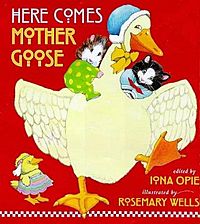Here Comes Mother Goose facts for kids
 |
|
| Author | Iona Opie (editor) |
|---|---|
| Illustrator | Rosemary Wells |
| Country | England |
| Language | English |
| Genre | Children's picture book |
| Published | 1999 (Candlewick Press) |
| Media type | Print (hardback) |
| Pages | 107 |
| ISBN | 9780763606831 |
| OCLC | 40856903 |
Here Comes Mother Goose is a children's picture book. It was put together by Iona Opie. This book is a collection of 56 well-known Mother Goose nursery rhymes. Iona Opie carefully chose these rhymes. This book is the second time she worked with the illustrator Rosemary Wells.
Contents
What is Mother Goose?
Mother Goose is a famous imaginary character. She is known for a large collection of classic nursery rhymes and fairy tales. These stories and rhymes are very old. They have been passed down through many generations. Mother Goose is often shown as an old woman. She wears a tall hat and flies on a goose. She tells stories and sings rhymes to children.
The History of Nursery Rhymes
Nursery rhymes are short poems or songs. They are usually for young children. Many of these rhymes are hundreds of years old. They started as folk songs or simple verses. People would sing them to their children. Over time, they became very popular. They help children learn language and rhythm. Some rhymes even teach simple lessons.
The name "Mother Goose" became popular in the 17th century. A French writer named Charles Perrault published a book of fairy tales. He called it "Tales of My Mother Goose." Later, in the 18th century, English publishers used the name. They used it for collections of children's rhymes. This made Mother Goose a household name.
About "Here Comes Mother Goose"
This book is a special collection of nursery rhymes. It brings together 56 different rhymes. These rhymes are chosen from the vast world of Mother Goose. The book was published in 1999. It quickly became a favorite for many families. The rhymes are presented in a fun and easy-to-read way.
The Creators: Iona Opie and Rosemary Wells
Iona Opie was a famous expert on children's folklore. She spent her life studying nursery rhymes. She collected and published many books of rhymes. Her work helped preserve these important verses. She made sure they would be remembered.
Rosemary Wells is a well-known children's book illustrator. She has drawn pictures for many popular books. Her drawings are often gentle and full of life. For "Here Comes Mother Goose," her illustrations bring the rhymes to life. They help young readers imagine the characters and actions. Her art makes the book even more enjoyable.
Why This Book is Special
"Here Comes Mother Goose" is special for several reasons. First, it has a wide variety of rhymes. Some are very famous, like "Twinkle, Twinkle, Little Star." Others might be less known but are just as charming. Second, the illustrations are beautiful. Rosemary Wells's art adds a lot to the book. Her pictures help tell the story of each rhyme. Finally, the book helps keep old traditions alive. It introduces classic rhymes to new generations of children.
The Magic of Nursery Rhymes
Nursery rhymes are more than just fun songs. They play an important role in a child's early learning. They help children develop many skills. These skills are important for reading and speaking.
Learning Through Rhyme
Nursery rhymes help children learn about sounds. They teach about rhythm and patterns in words. This is called phonological awareness. It is a key skill for learning to read. When children hear rhymes, they learn to predict words. They also learn to recognize different sounds.
Rhymes also help with memory. Children often memorize nursery rhymes easily. This helps them practice remembering things. It also builds their vocabulary. They learn new words and how to use them. Plus, rhymes are a great way to bond with family. Parents and children can sing them together. This creates happy memories and strengthens connections.

